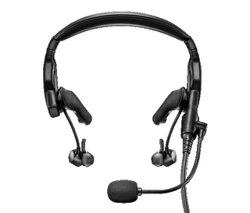Loading ...
Loading ...

IMPORTANT SAFETY INSTRUCTIONS
3
|
ENG
• Make sure portable devices do not interfere with the aircraft’s navigation and communication systems.
Reference FAA AC 91.21-1D, or later revision, for installation approval.
It is the pilot’s responsibility to ensure that portable devices do not interfere with the aircraft’s navigation and
communication systems, as well as to determine if the portable device is suitable for use with the headset.
• Use only AA alkaline batteries.
To avoid risk of explosion, replace the batteries only with AA alkaline batteries. Properly dispose of used batteries.
• Do NOT repair the headset yourself.
Contact the Bose organization in your country/region for specific care, return and shipping instructions.
Visit: global.Bose.com
• Do not use the headset with a helmet or as part of a crash protection system.
The headset is not intended for such use, and has not been certified for crash protection. Dismantling, reassembly
or modification of the headset, or any part, for use in a helmet or other crash protection system could result in
severe bodily injury and such unauthorized use will void the limited product warranty.
• Do NOT immerse the headset or any parts in water or any other liquid.
See “Clean the headset” on page 40 for cleaning instructions.
Contains small parts which may be a choking hazard. Not suitable for children under age 3.
This product contains magnetic material. Consult your physician on whether this might aect your
implantable medical device.
• Do NOT expose this product to dripping or splashing, and do not place objects filled with liquids, such as vases,
on or near the product.
• Do NOT make unauthorized alterations to this product.
• Do not expose products containing batteries to excessive heat (e.g. from storage in direct sunlight, fire or the like).
NOTE:
This equipment has been tested and found to comply with the limits for a Class B digital device, pursuant to Part
15 of the FCC Rules. These limits are designed to provide reasonable protection against harmful interference in a
residential installation. This equipment generates, uses, and can radiate radio frequency energy and, if not installed
and used in accordance with the instructions, may cause harmful interference to radio communications. However,
there is no guarantee that interference will not occur in a particular installation. If this equipment does cause harmful
interference to radio or television reception, which can be determined by turning the equipment o and on, the user
is encouraged to try to correct the interference by one or more of the following measures:
• Reorient or relocate the receiving antenna.
• Increase the separation between the equipment and receiver.
• Connect the equipment into an outlet on a circuit dierent from that to which the receiver is connected.
• Consult the dealer or an experienced radio/TV technician for help.
Changes or modifications not expressly approved by Bose Corporation could void the user’s authority to operate this
equipment.
This device complies with part 15 of the FCC Rules and with Industry Canada license-exempt RSS standard(s).
Operation is subject to the following two conditions: (1) This device may not cause harmful interference, and (2) this
device must accept any interference received, including interference that may cause undesired operation.
This device complies with FCC and Industry Canada radiation exposure limits set forth for general population.
This transmitter must not be co-located or operating in conjunction with any other antenna or transmitter.
Loading ...
Loading ...
Loading ...
